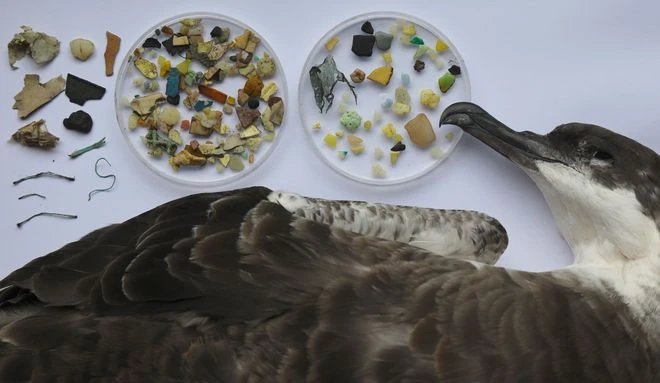Plastic pollution making its way into bodies of wildlife, humans

Quantifying the dangers of plastic pollution in the seas and nature, a team of researchers in a new study estimates that about half of the world’s seabirds have ingested plastic additives.
The researchers from Japan, the United States and other countries studied 145 seafowls of 32 species from 16 areas of the world.
They found brominated flame retardants and ultraviolet absorbers--the latter being used to prevent sunlight-induced degradation of plastics--in 76 of these, including in three streaked shearwaters from Awashima island in Niigata Prefecture, which were found polluted at mild concentrations.
Their findings appeared in the English-language journal of the Japan Society for Environmental Chemistry in October:(https://doi.org/10.5985/emcr.20210009).
In addition to the seabirds, plastic additives, or chemicals that are used in plastic products to prevent them from deteriorating or catching fire, have recently been found in the bodies of other wildlife, including hermit crabs, and some even in humans.
Experts are calling for closer studies to be conducted on, and countermeasures to be taken against, pollution by plastic additives, of which even very small quantities could have adverse health effects.
ENDOCRINE DISRUPTERS INCLUDED
Hideshige Takada, a professor of environmental science with Tokyo University of Agriculture and Technology (TUAT), who was part of the study, separately worked with his colleagues to study “Coenobita cavipes” land hermit crabs in Okinawa Prefecture.
The researcher found brominated flame retardants in their internal organs.
Their indoor experiments showed that plastic additives accumulate in the bodies of bivalves and saltwater fish when their food is admixed with plastic fragments.
Takada explained that plastic additives dissolve readily in oil and fat, although they are poorly soluble in water.
And there is fat and oil derived from food in the stomach and intestines of living creatures. A mechanism has been found wherein additives dissolve into that fat and oil in the body of a creature that has swallowed pieces of plastic by error, and end up partially absorbed.
Plastic additives, which include plasticizing agents for softening materials ahead of processing, account for about 7 percent of the raw materials of plastics.
Some of the plastic additives, such as bisphenol A (BPA) and phthalic esters (phthalates), are known as endocrine disruptors, which block the natural functions of hormones once they are in the bodies of living creatures, thereby causing abnormalities.
BPA, phthalates and other plastic additives abound as ingredients of products in our close surroundings, such as plastic containers and room wallpaper. They have also been found in human bodies.
Phthalates have short half-life periods--the time it takes until there is only half as much of them in the body as in the initial state--of only several hours to several days. Concerns have been raised, however, that constant exposure to the phthalates could still have unforeseen consequences.
‘IMPACT ON HUMANS COULD ALREADY BE THERE’
A group of researchers led by Reiko Kishi, a professor with the Hokkaido University Center for Environmental and Health Sciences, has been studying the content of chemicals in the blood of 20,000 mothers and their impact on the children of those subjects.
The research, titled the “Hokkaido Study on Environment and Children’s Health,” has been ongoing since 2001.
Their analysis of 250 or so mothers has so far indicated that the higher the concentrations of phthalates in the blood of mothers, the more prone their children are, until the age of 7, to develop food allergies and contract infectious diseases, such as middle ear inflammation and chicken pox.
Kishi and her coworkers’ study also showed that, the higher the blood concentrations of those substances in the mothers, the lower the concentration of leptin, a key hormone, tended to be in the cord blood.
The higher phthalate concentrations were also found correlated with lower concentrations at birth of a sex hormone that is secreted from the spermaries of boys.
“The impact of plastic additives on humans could already be there,” Kishi said. “That problem is less obvious than that of marine plastic litter, in which there is mounting interest, but it still deserves more attention.”
The problem of marine plastic litter has been drawing attention in recent years.
Broken down by ultraviolet rays and sea waves, plastic products crumble into microplastics, measuring 5 millimeters or less, which pollute the ocean. Apart from their content of additives, the microplastics could bind with dioxins and other toxic chemicals, which, in turn, could enter the human body through the food chain, and hence the concerns.
An “Osaka Blue Ocean Vision,” a plan that aims to reduce additional pollution by marine plastic litter to zero by 2050, was released during a Group of 20 Summit held in Osaka in 2019. The marine plastic litter issue is also expected to be discussed at a session of the U.N. Environment Assembly that will be held in Nairobi in 2022.
In Japan, retailers have been required since July 2020 to charge for plastic shopping bags. Disposable plastic products, such as throwaway spoons distributed at convenience stores, will also stop being free of charge next spring.
To reduce plastic waste, a plan is also being floated for making plastic products eligible for an existing recycling setup, which now only covers plastic containers and packaging.
Takada pointed out, however, that additives contained in plastic waste could volatilize when heated during the recycling process and thereby end up in the human body. Recycling could also make it unable to tell what additives are contained in given plastic products, he added.
“It is therefore essential to reduce the use of plastic products or to replace plastic additives with harmless ones,” Takada said.
